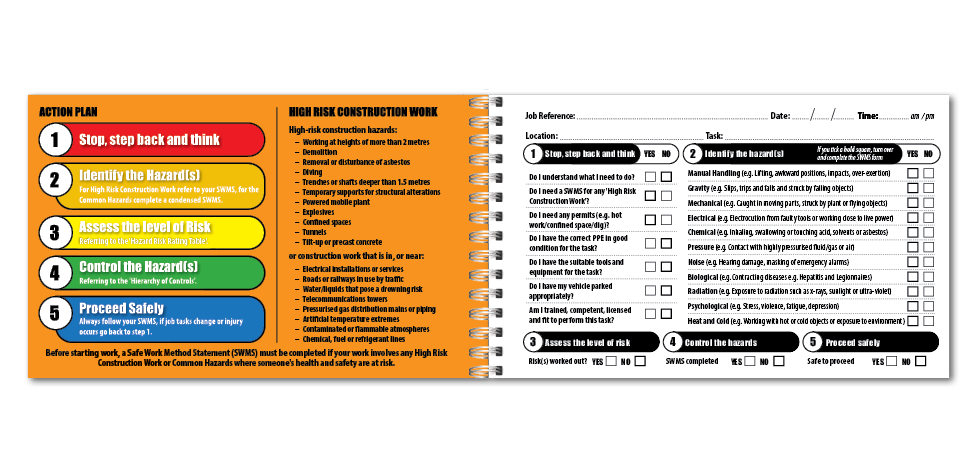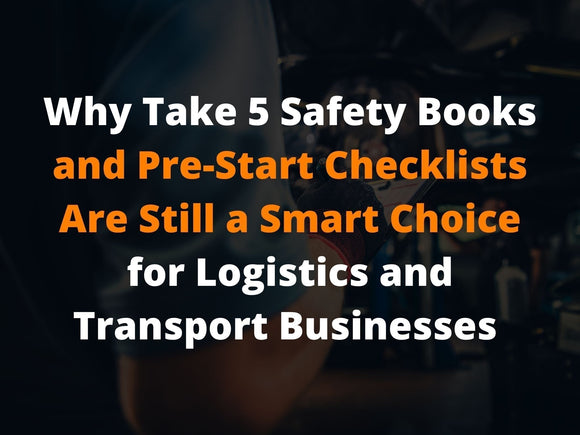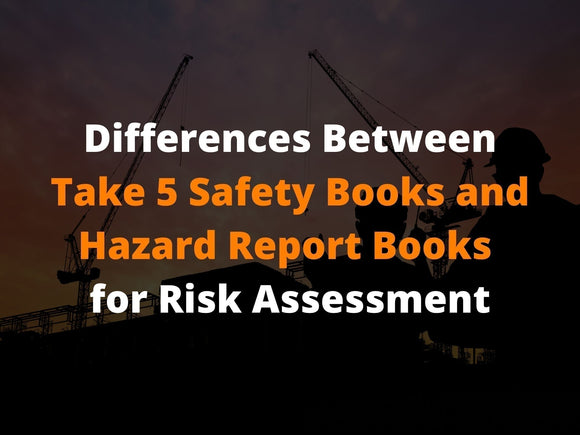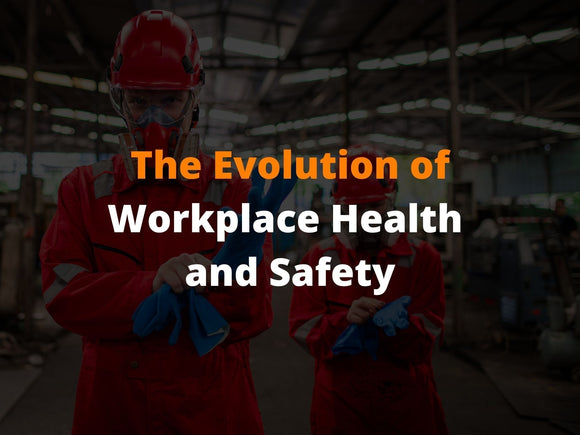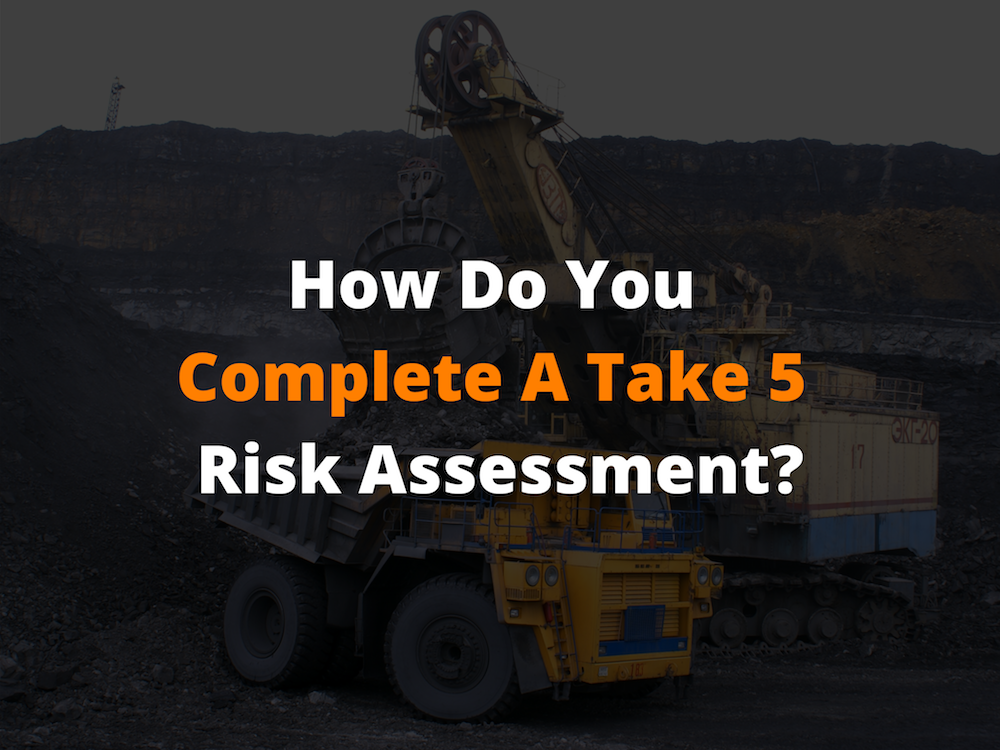
How Do You Complete A Take 5 Risk Assessment?
When it comes to managing risks in the workplace, every staff member has an obligation and responsibility to ensure their own safety, as well as the safety of those around them. Every work area and task can pose a potential risk to personnel, property or environment. These risks are heightened if inexperienced staff members perform the task, and risk is increased when there are changes to work practices or environmental conditions.
Managing these risks is the foundation of workplace safety, and can make the difference for your staff to safely complete their tasks. One of the quickest and most effective ways to do this is by adopting Take 5 Risk Assessment books.
Firstly, What is a Risk Assessment?
Simply put – a A Risk Assessment means looking at each specific task and determining its safety, and the most effective way to complete that task. Risk management is the responsibility of all staff members.
A common and effective tool used to complete Risk Management is the Take 5 Booklet. As mentioned above, This booklet is used by individual staff members, and it is their personal risk assessment tool to assist in maintaining awareness of their working environment. It allows them to identify and control immediate hazards that can occur in their day-to-day work.
What is Take 5 Safety?
Take 5 Safety is a simple and effective way to increase safety awareness in the workplace.
Take 5 safety books are an easy and efficient way for staff to identify and report hazards and risks in the workplace.
UniPrint is one of Australia’s leading printers for Take 5 Safety books. We provide a range of pocket sized Take 5 books that can be used across various industries such as construction and manufacturing. We also provide fully customised safety books where the company can customise the safety book according to their specific needs.
What is a Take 5 Safety Booklet?
The Take 5 Safety Checklist is an assessment process which is simple, and an effective way to help increase your awareness and reduce the risk of an incident occurring in your workplace.
This personal risk assessment involves you personally giving a rating to the level of risk associated with an identified hazard. Once identified, controls can then be put in place to help eliminate or reduce the risk to an acceptable level.
The level of risk identified needs to be assessed by 2 factors:
- The likelihood of the risk occurring
- The consequence (level of harm or damage) of the hazard
How Does a Take 5 Safety Book Reduce Workplace Risks?
Staff members utilise the Take 5 safety book at the start of their shift, prior to starting work on any job or piece of equipment. Having this as a standard safety procedure in the workplace, allows staff to follow routine safety requirements and ensure they do not get complacent. Completing the safety checklist ensures any potential risks are identified before the job is started. If any hazards or potential risks are identified, these can be effectively assessed, managed and monitored which creates a safer workplace overall.
The Take 5 Safety Checklist is a one page checklist that can be completed within 5 minutes. When completed correctly, staff have a greater understanding and awareness of their workplace surroundings.
How Do You Complete Take 5?
When looking at the take 5 safety procedure, the Take 5 Safety Steps are:
- STOP, step back and THINK
- Identify the hazards
- Assess the level of risk
- Control the hazards
- Proceed safely
These are standardised steps that can be applied to most workplaces. If you have your Take 5 Safety booklet with you, follow along with it as you read through the steps in greater detail below.
Step One: STOP, step back and THINK
The first thing you want to do before starting work on any project is to engage your brain to help make it aware of any potential hazards.
Complete a Take 5 checklist before starting any task, OR during a task where there is a change of conditions. This checklist helps you to identify the risks to yourself, your workmates, equipment, property or environment.
Every staff member should have and maintain their own Take 5 booklet.
Using your own Take 5 book – find the next available checklist, and write down your name, location and today’s date.
THINK about your Tasks
Go through the questions of Section 1 (Stop, Step Back and Think) and tick the relevant yes/no boxes. For any of the questions where you tick the bold boxes on this checklist, you should NOT proceed with your tasks. Instead, be sure to contact your supervisor and wait until the question has been addressed.
The purpose of these questions is to help identify any relevant permits, procedures or training that must be in place before commencing your work.
- Processes: Be mindful of any existing tasks or procedures. If there is any change to the way tasks are done, it is important not to be complacent, and to identify where any new hazards have been introduced. If so, a change in processes must be managed.
- Permits: For any permits, think about the work you need to complete, and if any of those tasks have their own separate permit processes. Ask your supervisor if you’re unsure about the requirements of any high-risk tasks you have to do.
- Training: Ensure that you have (or have access to) relevant training to perform the tasks you need to do. Check that you are competent and licensed to complete your work safely.
- Personal Protective Equipment (PPE): check that you have the appropriate PPE you need to complete your tasks. PPE can include equipment such as: breathing apparatus, hearing protection, life preserver, water, sunscreen etc. Not only that, but check that your equipment is still not out of date, and in good condition.
- Clarity: check that you have a clear plan in mind to complete your work. Do you know what is required? If not, be sure to ask for clarification.
Step Two: IDENTIFY the Hazards
In this step, you want to be able to identify any potential hazards in your work area. The questions of the Take 5 Checklist help you to identify any hazards that might cause harm to you, to others, to equipment, or to the surrounding environment.
If you do not tick any of the bold boxes, then it is safe to proceed with the task. However, ticking a bold box identifies a potential hazard, and must be addressed.
Step Three: ASSESS the Risks
If you have any bold boxes ticked from Step 1 or Step 2, then the level of risk must now be assessed. This is done by identifying the Risk Rating Score of the risk. The risk rating score can be determined by using the Hazard Risk Rating Table at the back of the Take 5 Booklet.
Determining the Risk Rating Score
When referring to the Hazard Risk Rating Table, choose how severe the hazard’s consequence will be. For example, if it could cause death, then refer to the Catastrophic column of the table.
Next, determine how likely the consequence is going to happen. For example, if it will most likely occur in most circumstances, then you would class then refer to the Very Likely row of the table.
Once you have your Consequence and Likelihood rating, look at where these two points meet on the table and you will now have your Risk Rating of either:
- High Risk: stop work immediately.
- Medium Risk: contact your supervisor before starting the task.
- Low Risk: speak with your tradesperson in charge to agree with any controls needed.

Step Four: CONTROL the Hazard
To help plan and implement Control of any identified hazard, you will need to fill out the Safe Work Method Statement (SWMS) section of the Take 5 Booklet. Fill this section out when you have any bold boxes ticked from Step 1 or Step 2. Work out how best to control these hazards and write them down too.
When describing the hazard, be concise and clear in your description. Enter your risk rating of the hazard (identified from Step 3). This is your risk rating without any controls already in place.
TIP: Use the Hierarchy of Controls to help choose the best method. This is found on the back page of your Take 5 Booklet. Some types of controls are more effective than others, depending on the hazard. If you cannot eliminate the hazard, then use the most appropriate control to keep the lowest risk of the incident happening.

Finally, check to make sure your new controls do not create any new hazards that you need to account for. For example, a control to reduce dust in a workplace could involve using water, but does that water create a slipping hazard?
Step Five: PROCEED safely
Working together with your Tradesperson or Supervisor in charge – once you have your agreed Controls in place and reported the hazard, you can now safely proceed with your work tasks.
Continue to monitor the effectiveness of these controls, and look for any changes to the task or your work area/environment. Any changes to this could introduce new hazards and if so, a new Take 5 Checklist may need to be completed.
Are you interested in adopting Take 5 Books in your workplace?
UniPrint is Australia’s leading Take 5 Booklet printer, and has over 10 years’ experience in safety book printing. Our Take 5 Books are fully customisable and easy to use.
We also have FREE Take 5 Online Training which provides certified training for your staff, ensuring they know how to successfully use their Take 5 Safety Books in the workplace. Contact us today to discuss your requirements.

